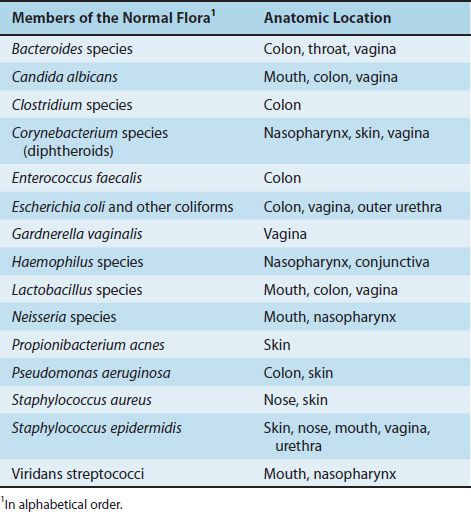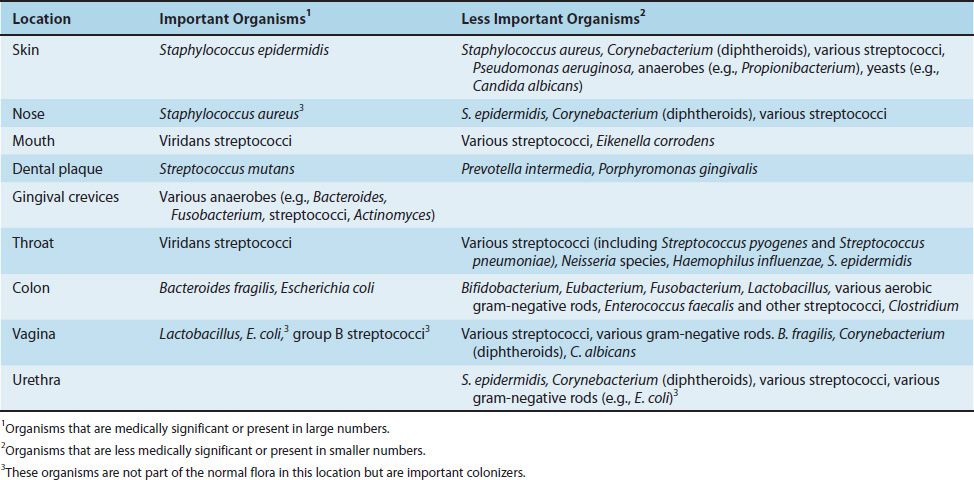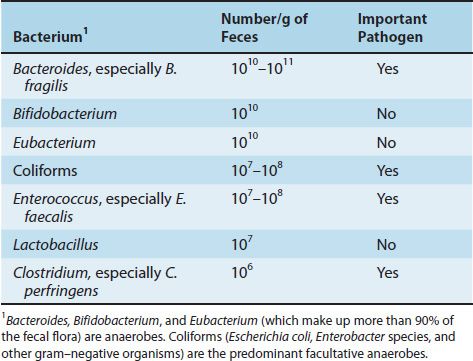6
Normal Flora
CHAPTER CONTENTS
CONCEPT OF NORMAL FLORA
Normal flora is the term used to describe the various bacteria and fungi that are permanent residents of certain body sites, especially the skin, oropharynx, colon, and vagina (Tables 6–1 and 6–2). Viruses and parasites (protozoa and helminths), which are the other major groups of microorganisms, are usually not considered members of the normal flora, although they can be present in asymptomatic individuals. The normal flora organisms are often referred to as commensals. Commensals are organisms that derive benefit from another host but do not damage that host.
TABLE 6–1 Summary of the Members of Normal Flora and Their Anatomic Locations

TABLE 6–2 Medically Important Members of the Normal Flora

The term human microbiome is often used to describe the normal flora. Using sophisticated molecular diagnostic techniques, many new bacteria have been identified as members of the microbiome. The role of these bacteria in immune system function and as the cause of disease is being investigated.
The members of the normal flora vary in both number and kind from one site to another. Although the normal flora extensively populates many areas of the body, the internal organs usually are sterile. Areas such as the central nervous system, blood, lower bronchi and alveoli, liver, spleen, kidneys, and bladder are free of all but the occasional transient organism.
There is a distinction between the presence of these organisms and the carrier state. In a sense, we all are carriers of microorganisms, but that is not the normal use of the term in the medical context. The term carrier implies that an individual harbors a potential pathogen and therefore can be a source of infection of others. It is most frequently used in reference to a person with an asymptomatic infection or to someone who has recovered from a disease but continues to carry the organism and may shed it for a long period.
There is also a distinction to be made between members of the normal flora, which are the permanent residents, and the colonization of the individual with a new organism. In a sense, we are all colonized by the normal flora organisms, but the term colonization typically refers to the acquisition of a new organism. After the new organism colonizes (i.e., attaches and grows, usually on a mucosal membrane), it may cause an infectious disease, or it may be eliminated by our host defenses. Furthermore, the person colonized by a new organism can transmit that organism to others (i.e., act as a reservoir of infection for others).
The members of the normal flora play a role both in the maintenance of health and in the causation of disease in three significant ways:
(1) They can cause disease, especially in immunocompromised and debilitated individuals. Although these organisms are nonpathogens in their usual anatomic location, they can be pathogens in other parts of the body.
(2) They constitute a protective host defense mechanism. The nonpathogenic resident bacteria occupy attachment sites on the skin and mucosa that can interfere with colonization by pathogenic bacteria. The ability of members of the normal flora to limit the growth of pathogens is called colonization resistance. If the normal flora is suppressed, pathogens may grow and cause disease. For example, antibiotics can reduce the normal colonic flora that allows Clostridium difficile, which is resistant to the antibiotics, to overgrow and cause pseudomembranous colitis.
(3) They may serve a nutritional function. The intestinal bacteria produce several B vitamins and vitamin K. Poorly nourished people who are treated with oral antibiotics can have vitamin deficiencies as a result of the reduction in the normal flora. However, since germ-free animals are well-nourished, the normal flora is not essential for proper nutrition.
NORMAL FLORA OF THE SKIN
The predominant organism is Staphylococcus epidermidis, which is a nonpathogen on the skin but can cause disease when it reaches certain sites, such as artificial heart valves and prosthetic joints. It is found on the skin much more frequently than its pathogenic relative Staphylococcus aureus (Table 6–2). There are about 103–104 organisms/cm2 of skin. Most of them are located superficially in the stratum corneum, but some are found in the hair follicles and act as a reservoir to replenish the superficial flora after hand washing. Anaerobic organisms, such as Propionibacterium and Peptococcus, are situated in the deeper follicles in the dermis, where oxygen tension is low. Propionibacterium acnes is a common skin anaerobe that is implicated in the pathogenesis of acne.
The yeast Candida albicans is also a member of the normal flora of the skin. It can enter a person’s bloodstream when needles pierce the skin (e.g., in patients with intravenous catheters or in those who use intravenous drugs). It is an important cause of systemic infections in patients with reduced cell-mediated immunity.
NORMAL FLORA OF THE RESPIRATORY TRACT
A wide spectrum of organisms colonize the nose, throat, and mouth, but the lower bronchi and alveoli typically contain few, if any, organisms. The nose is colonized by a variety of streptococcal and staphylococcal species, the most significant of which is the pathogen S. aureus. Occasional outbreaks of disease due to this organism, particularly in the newborn nursery, can be traced to nasal, skin, or perianal carriage by health care personnel.
The throat contains a mixture of viridans streptococci, Neisseria species, and S. epidermidis (Table 6–2). These nonpathogens occupy attachment sites on the pharyngeal mucosa and inhibit the growth of the pathogens Streptococcus pyogenes, Neisseria meningitidis, and S. aureus, respectively.
In the mouth, viridans streptococci make up about half of the bacteria. Streptococcus mutans, a member of the viridans group, is of special interest since it is found in large numbers (1010/g) in dental plaque, the precursor of caries. The plaque on the enamel surface is composed of gelatinous, high-molecular-weight glucans secreted by the bacteria. The entrapped bacteria produce a large amount of acid, which demineralizes the enamel and initiates caries. The viridans streptococci, such as S. sanguinis, are also the leading cause of subacute bacterial (infective) endocarditis. These organisms can enter the bloodstream at the time of dental surgery and attach to damaged heart valves.
Eikenella corrodens, also part of the normal oral flora, causes skin and soft tissue infections associated with human bites and “clenched-fist” injuries (i.e., injuries to the hand that occur during fist fights).
Anaerobic bacteria, such as species of Bacteroides, Prevotella, Fusobacterium, Clostridium, and Peptostreptococcus, are found in the gingival crevices, where the oxygen concentration is very low. If aspirated, these organisms can cause lung abscesses, especially in debilitated patients with poor dental hygiene. In addition, the gingival crevices are the natural habitat of Actinomyces israelii—an anaerobic actinomycete that can cause abscesses of the jaw, lungs, or abdomen.
NORMAL FLORA OF THE INTESTINAL TRACT
In normal fasting people, the stomach contains few organisms, primarily because of its low pH. The small intestine usually contains small numbers of streptococci, lactobacilli, and yeasts, particularly C. albicans. Larger numbers of these organisms are found in the terminal ileum.
The colon is the major location of bacteria in the body. Roughly 20% of the feces consists of bacteria, approximately 1011 organisms/g. The major bacteria found in the colon are listed in Table 6–3. Note that more than 90% of the fecal flora are anaerobes, the most important of which is Bacteroides fragilis. The most abundant facultative bacteria are the coliforms, of which Escherichia coli is the most important.
TABLE 6–3 Major Bacteria Found in the Colon

Stay updated, free articles. Join our Telegram channel

Full access? Get Clinical Tree


